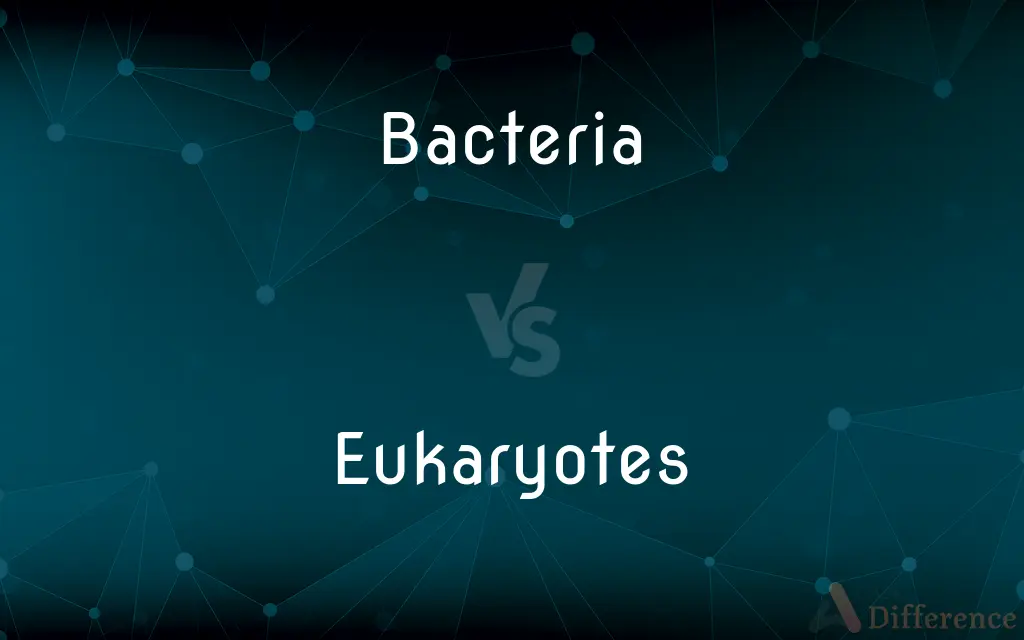Bacteria vs. Eukaryotes — What's the Difference?
Edited by Tayyaba Rehman — By Fiza Rafique — Published on October 3, 2023
Bacteria are single-celled prokaryotes without a nucleus, while eukaryotes have a nucleus and include both single-celled and multicellular organisms.

Difference Between Bacteria and Eukaryotes
Table of Contents
ADVERTISEMENT
Key Differences
Bacteria are among the simplest forms of life and belong to the domain of prokaryotes. Eukaryotes, on the other hand, are more complex and have cells that contain a nucleus and other membrane-bound organelles.
Bacteria often thrive in various environments, from hot springs to the human gut. Eukaryotes also occupy diverse habitats, but their cellular structure allows them to form more intricate multicellular organisms, like plants and animals.
In terms of genetics, bacteria typically have a single circular chromosome located in a region called the nucleoid. Eukaryotes, in contrast, have multiple linear chromosomes housed within the nucleus.
Reproduction in bacteria mainly occurs through a process called binary fission, which is a type of asexual reproduction. Eukaryotes employ a wider array of reproductive methods, including both asexual and sexual reproduction, with meiosis and mitosis playing crucial roles.
While bacteria possess cell walls made of peptidoglycan, eukaryotic cells might have a variety of outer layers, such as the cellulose cell wall in plants or the chitinous layer in fungi. Animal eukaryotes, notably, lack a cell wall altogether.
ADVERTISEMENT
Comparison Chart
Cellular Complexity
Simple prokaryotic cells without nucleus
Complex cells with a nucleus and other organelles
Habitat
Everywhere, including extreme conditions
Various, from single-cell to multicellular organisms
Genetic Material
Single circular chromosome in nucleoid
Multiple linear chromosomes in a nucleus
Reproduction
Mainly binary fission
Both asexual (mitosis) and sexual (meiosis) reproduction
Cell Wall Composition
Peptidoglycan
Varies (cellulose in plants, chitin in fungi, none in animals)
Compare with Definitions
Bacteria
Prokaryotic organisms.
The human gut contains beneficial bacteria aiding in digestion.
Eukaryotes
Possessors of membrane-bound organelles.
Eukaryotes have structures like mitochondria and endoplasmic reticulum in their cells.
Bacteria
Single-celled microorganisms without a nucleus.
Bacteria can cause diseases but also play crucial roles in ecosystems.
Eukaryotes
Entities with complex cellular structures.
The complexity of eukaryotes allows them to form specialized tissues and organs.
Bacteria
Capable of rapid reproduction via binary fission.
Some bacteria can double their population in just 20 minutes.
Eukaryotes
Organisms with cells containing a nucleus.
Humans, plants, and fungi are all eukaryotes.
Bacteria
Ubiquitous life forms existing in diverse environments.
Bacteria can be found in soil, water, and even in extreme conditions like hot springs.
Eukaryotes
Can be single-celled or multicellular.
While amoebas are single-celled eukaryotes, trees are multicellular.
Bacteria
Possessors of cell walls made of peptidoglycan.
Antibiotics often target the peptidoglycan layer in bacteria.
Eukaryotes
Employ varied reproductive methods.
Eukaryotes can reproduce through mitosis or more complex processes like meiosis.
Bacteria
Bacteria ( (listen); common noun bacteria, singular bacterium) are a type of biological cell. They constitute a large domain of prokaryotic microorganisms.
Eukaryotes
Any of various single-celled or multicellular organisms of the domain Eukaryota, characterized by cells that contain a distinct membrane-bound nucleus and by the occurrence of DNA transcription inside the nucleus and protein synthesis in the cytoplasm, in contrast to prokaryotes.
Bacteria
Plural of bacterium.
Eukaryotes
Plural of eukaryote
Bacteria
(US) A type, species, or strain of bacterium.
Bacteria
Alternative form of bacterium.
Bacteria
Lowlife, slob (could be treated as plural or singular).
Bacteria
An oval bacterium, as distinguished from a spherical coccus or rod-shaped bacillus.
Bacteria
See Bacterium.
Bacteria
(microbiology) single-celled or noncellular spherical or spiral or rod-shaped organisms lacking chlorophyll that reproduce by fission; important as pathogens and for biochemical properties; taxonomy is difficult; often considered plants
Common Curiosities
Do bacteria have a nucleus?
No, bacteria lack a nucleus and have their genetic material in a nucleoid region.
Are all bacteria harmful to humans?
No, while some bacteria cause diseases, many are beneficial or neutral to humans.
Are all eukaryotes multicellular?
No, eukaryotes can be both single-celled and multicellular.
Which organisms are considered eukaryotes?
Organisms like plants, animals, fungi, and certain protists are eukaryotes.
How do eukaryotic cells differ in structure from bacterial cells?
Eukaryotic cells have a nucleus and other organelles, while bacterial cells are simpler without a nucleus.
Do eukaryotes have organelles?
Yes, eukaryotes have membrane-bound organelles, including a nucleus.
What are bacteria?
Bacteria are single-celled prokaryotes without a nucleus.
Are fungi bacteria or eukaryotes?
Fungi are eukaryotes with complex cellular structures.
What's the primary reproductive method for bacteria?
Bacteria mainly reproduce asexually through binary fission.
What is the significance of bacteria in ecosystems?
Bacteria play crucial roles in nutrient cycling, decomposition, and forming symbiotic relationships.
Share Your Discovery

Previous Comparison
Controllable Costs vs. Non Controllable Costs
Next Comparison
Acceptably vs. WellAuthor Spotlight
Written by
Fiza RafiqueFiza Rafique is a skilled content writer at AskDifference.com, where she meticulously refines and enhances written pieces. Drawing from her vast editorial expertise, Fiza ensures clarity, accuracy, and precision in every article. Passionate about language, she continually seeks to elevate the quality of content for readers worldwide.
Edited by
Tayyaba RehmanTayyaba Rehman is a distinguished writer, currently serving as a primary contributor to askdifference.com. As a researcher in semantics and etymology, Tayyaba's passion for the complexity of languages and their distinctions has found a perfect home on the platform. Tayyaba delves into the intricacies of language, distinguishing between commonly confused words and phrases, thereby providing clarity for readers worldwide.
















































